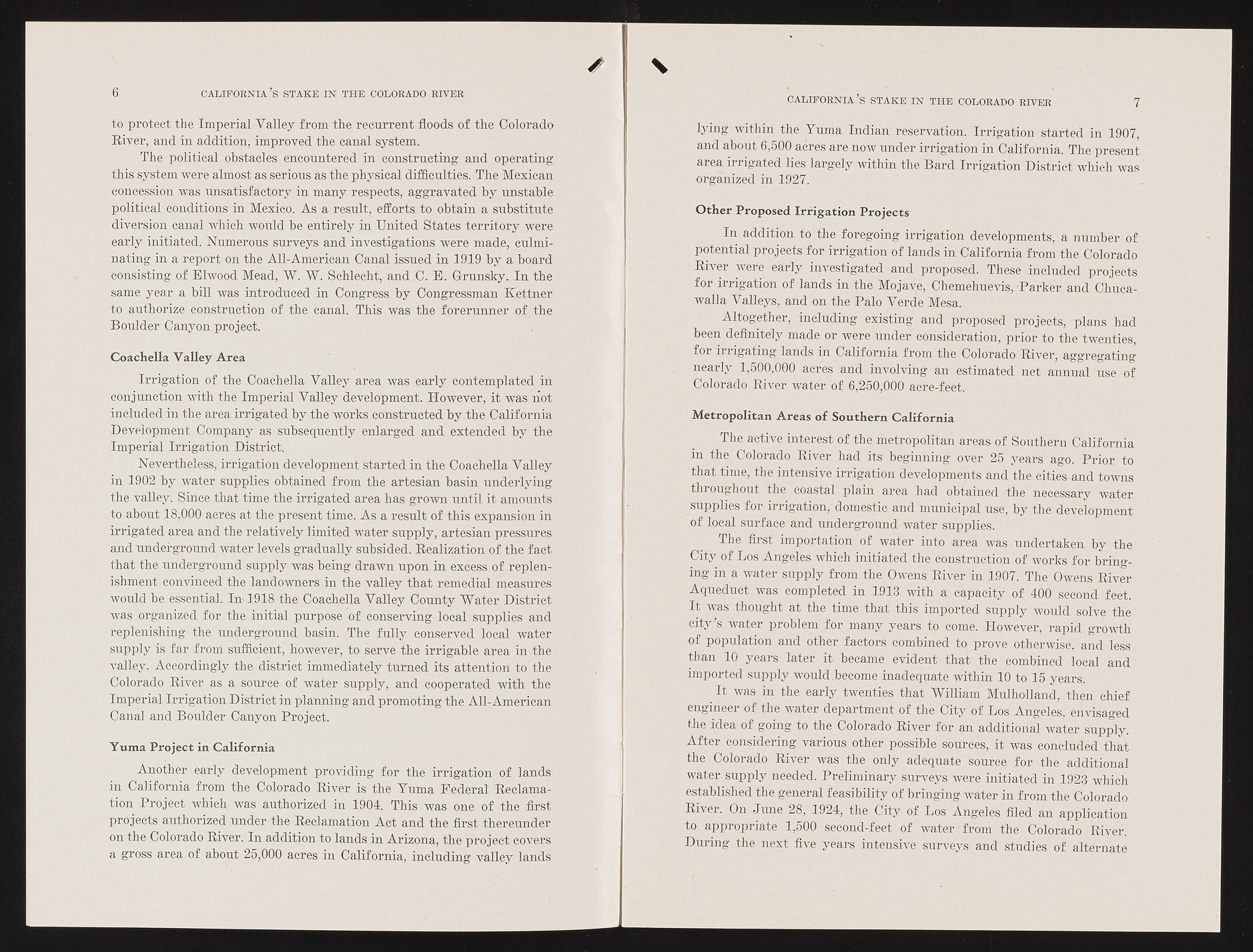Copyright & Fair-use Agreement
UNLV Special Collections provides copies of materials to facilitate private study, scholarship, or research. Material not in the public domain may be used according to fair use of copyrighted materials as defined by copyright law. Please cite us.
Please note that UNLV may not own the copyright to these materials and cannot provide permission to publish or distribute materials when UNLV is not the copyright holder. The user is solely responsible for determining the copyright status of materials and obtaining permission to use material from the copyright holder and for determining whether any permissions relating to any other rights are necessary for the intended use, and for obtaining all required permissions beyond that allowed by fair use.
Read more about our reproduction and use policy.
I agree.Information
Digital ID
Permalink
Details
Member of
More Info
Rights
Digital Provenance
Publisher
Transcription
6 CALIFORNIA'S STAKE IN THE COLORADO RIVER to protect the Imperial-Valley from the recurrent floods of the Colorado River, and in addition, improved the canal system. The political obstacles encountered in constructing and operating this system were almost as serious as the physical difficulties. The Mexican concession was unsatisfactory in many respects, aggravated by unstable political conditions in .Mexico. As a result, efforts to obtain a substitute diversion canal which would be entirely in United States territory were early initiated. Numerous surveys and investigations were made, culminating in a report on the All-American Canal issued in 1919 by a board consisting of Elwood Mead, W. W. Schlecht, and C. E. Grunsky. In the same year a bill was introduced in Congress by Congressman Kettner to authorize construction of the canal. This was the forerunner of the Boulder Canyon project. Coachella Valley Area Irrigation of the Coachella Valley area was early contemplated in conjunction with the Imperial Valley development. However, it was not included in the area irrigated by the works constructed by the California Development Company as subsequently enlarged and extended by the Imperial Irrigation District. Nevertheless, irrigation development started in the Coachella Valley in 1902 by water supplies obtained from the artesian basin underlying the valley. Since that time the irrigated area has grown until it amounts to about 18,000 acres at the present time. As a result of this expansion in irrigated area and the relatively limited water supply, artesian pressures and underground water levels gradually subsided. Realization of the fact that the underground supply was being drawn upon in excess of replenishment convinced the landowners in the valley that remedial measures would be essential. In-1918 the Coachella Valley County Water District was organized for the initial purpose of conserving local supplies and. replenishing the underground basin. The fully conserved local water supply Is far from sufficient, however, to serve the irrigable area in the. valley. Accordingly the districtRmmediately turned its attention to the Colorado River as a. source of water supply, and cooperated with the Imperial Irrigation District in planning and promoting the A lb American Canal and Boulder Canyon Project. Yuma Project in California Another early development providing for the irrigation of lands In California from the Colorado River is the Yuma Federal Reclamation Project which was authorized in 1904, This was one of the first projects authorized under the Reclamation Act and the first thereunder on the Colorado River, In addition to lands in Arizona, the project covers a gross area of about 25,000 acres in California, including valley lands CALIFORNIA’S STAKE IN THE COLORADO RIVER 7 lying within the Yuma Indian reservation. Irrigation started in 1907, and about 6,500 acres are now under irrigation in California. The present area irrigated lies largely within the Bard Irrigation District which was organized in 1927. Other Proposed Irrigation Projects In addition to the foregoing irrigation developments, a number of potential projects for irrigation of lands in California from the Colorado River Were early investigated and proposed. These included projects for irrigation Of lands in the Mojave, Chemehuevis, 'Parker and Chuca-walla Valleys, and on the Palo Verde Mesa. Altogether, including existing and proposed projects, plans had been definitely made or were under consideration, prior to the twenties, for irrigating lands in California from the Colorado River, aggregating nearly 1,500,000 acres and involving an estimated net annual use of Colorado River water of 6,250,000 acre-feet. Metropolitan Areas of Southern California The active interest of the metropolitan areas of Southern California in the Colorado River had its beginning over 25 years'ago. Prior to that time, the intensive irrigation developments and the cities and towns throughout, the coastal plain area had obtained the necessary wafer supplies for irrigation, domestic and municipal use, by the development of local surface and underground water supplies, - The first importation of wafer into area was undertaken by the City of Los Angeles which initiated the construction of works for bringing in a water supply from the Owens River in 1907. The Owens River Aqueduct was completed in 1913 with a capacity of 400 second feet. It was .thought at the time that this imported supply would solve the city’s water problem for many years to come. However, rapid growth of population and other factors combined to prove otherwise, and less than 10 years later it became -evident that the combined local and imported supply would.become inadequate within 10 to 15 years. It was in the; early twenties that 'Winiam'Mulholland, then chief engineer of the water department of the City of Los Angeles, envisaged the idea of going to the Colorado River for an additional water supply. After considering various other possible sources, it was concluded that the- Colorado River was the only adequate sourceVfor the additional water supply needed. Preliminary surveys were initiated in 1923 which established the general feasibility of bringing water in from the Colorado River. On June 28, 1924, the City of Los Angeles filed an application to appropriate 1,500 second-feet of water from the Colorado River. During the next five fears intensive surveys and studies of alternate

